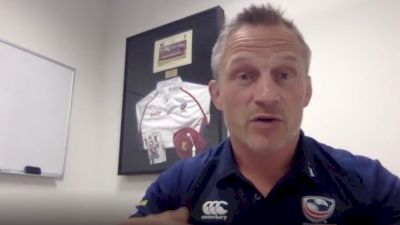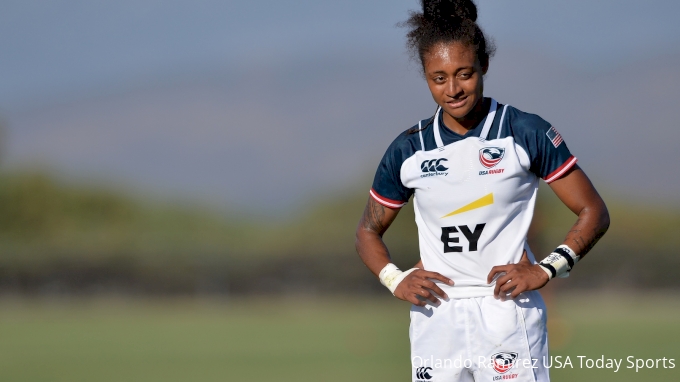Q&A With USA Rugby's Mark Griffin
Q&A With USA Rugby's Mark Griffin
Mark Griffin speaks with Alex Goff

FloRugby caught up with USA Rugby Chief Commercial Officer Mark Griffin to talk about the new USA Rugby partnership with EY in the wake of the two organizations’ announcement about the deal.
The EY deal isn’t just about branding on a rugby shirt, it’s about addressing some important business and organizational issues within USA Rugby.

It’s no secret that USA Rugby has undergone some major restructuring and leadership changes, and with every change there’s a call for better planning, and a more organized corporate approach.
This, said Griffin, is what EY brings as part of the deal.
FloRugby: What makes this more than just a sponsorship?
Griffin: Three things over and above what you’d get from a sponsorship, which is financial contribution for rights and benefits—for example, branding placement across various assets, event and digital activations, and hospitality opportunities.
This partnership includes all these pieces at the core. However, in addition, we benefit from a significant value value-in-kind:
- Strategic planning
- Data and analytics for improved fan activation and engagement
- Exploring programs to support us in driving inclusivity and embracing diversity throughout USA Rugby.
So in conclusion, it gives us significant credibility, quite a lot of insight, and it opens up future opportunities.
FloRugby: So EY is bringing their expertise to work for USA Rugby. What’s job #1 for you then?
Griffin: Yeah, firstly, look, they’re a world leader in this advisory space, so that’s a large part of what this partnership is about for us. … when I was talking about the credibility side it’s largely in the delivery of these services; and they’re providing us credibility because of their brand and who they are, but also in the services we’re getting.
The first one we’ve been really working on with EY is strategic planning. It’s been six weeks or so in the process … they brought in their head of strategy to work with us and all the senior team and executives and board and interviewing a number of different stakeholders.
So we’re very close now to being able to publish a ten-year strategic planning framework. And I think that’s something that a lot of people in the broader rugby constituency would be interested in.
FloRugby: Getting a company of EY’s reputation to go through your organization and look for things to improve can be painful at times, maybe. Was it?
Griffin: Not really for me. I think like any planning process at times probably can get a little bit frustrating because you can’t quite get the right answer or you’re spinning wheels a little. But the technology they’ve been able to bring to the process to capture all of the insights that we’ve had in these different workshops that we’ve done, nothing’s really got missed and it’s really I think minimized potential frustration.
I tell you what probably was one of the hardest things to do was — we came up with all these priority initiatives with EY, and of course the hardest thing is, we can’t do all of them.
One of the most important things you get from a strategic plan, assuming you follow up with it, is just as much what you’re not going as well as what you are going to do.

FloRugby: Follow-up is a crucial part of it; does EY get involved in that?
Griffin: What they’re offering is more on the execution. Part of it is more in the data analytic space, which is kind of over my head. We’re looking at fan base activation. The process for that … is to analyze the data that we have and how can we translate that into the different personas we interact with, and let’s work out with each of these personas, what’s the value proposition for them, and what can we deliver over time?
The next part is to build our fan base. How can we connect with all of the people who are followers and fans of rugby and how can we bring them in and make them fans of USA Rugby and bring in our other partners to create that stickiness that keeps them engaged.
FloRugby: So you’re looking at a type of member, say, a women’s D2 college player, and looking at what she gets out of USA Rugby and how you keep her involved whether she continues to play or not or remains a fan.
Griffin: Sure, that particular example you could apply to any player at any level of the game. That’s only one piece. There’s components on fan activation and who comes to events - where did they come from? How many are members? How many came into town or were based in the local area?
For players in particular, we obviously want to identify where they’re playing, how long they’ve been playing and if they stopped playing—Why? Is there an automated mechanism we can work in, where if somebody stopped playing we can reach out to them and say “Hey, do you mind just spending one minute to click these five questions to let us know why you stopped playing?”
We’ve done some of this in the past but it’s never been operationalized into the digital and data aspect of what we do. Those sorts of things will bring value to us over time as we can prioritize decisions based on data and facts rather than assumptions.

FloRugby: And then the data can help you form conclusions and action items.
Griffin: 100 percent. I think that a lot of this will inform the initiatives that will be outlined in the strategic plan. This particular area fits on the pillar of “growing the game”. One of the ways to grow the game is to retain players, and the other way to grow the game is to activate new players.
FloRugby: You talk about potential fans and fans of the game and getting them to “connect” to USA Rugby. Does that translate into whether there’s a fan’s membership process, or are you just looking for people to buy more tickets to see the Eagles play?
Griffin: Yes and yes. One of the things this clearly does is redefine what’s a member. We absolutely need a way of engaging grassroots-level donors all the way up to Golden Eagle-level donors.
Understanding who is coming to games so we can build the fan base.
Getting more donors and supporters, or just fans—people who might buy a jersey.
There’s lots of different ways that this is going to shake out. Once we complete the strategic plan we deep dive into the digital piece, and then spend the time toward the potential renewal of the partnership, executing the plan.
FloRugby: How important was it for the Men’s and Women’s sevens teams to achieve early qualification to the Olympics?
Griffin: Talk about making my job easier. Clearly it’s helped considerably by the men and women who have done phenomenally well on the World Sevens Series. That was certainly one of the things that attracted EY in the first place.
So, it’s incredibly important. It certainly helps us in terms of being able to sell the future and the potential of the game.
FloRugby: What’s a win for you on this partnership?
Griffin: I would define that by the primary things we’re getting out of it.
For me, 1) it’s provided a significant amount of credibility because of the association [with EY] and that, if you like, is the branding component of the partnership. 2) I think it’s really helping us inform our go-forward strategy in a way that’s going to enable us to be more successful. And 3) I think it’s going to open up additional opportunities; not just indirect opportunities because we’ve got a good strategy but, just though connectivity through EY and the massive companies that they’re associated with, many of whom have senior executives who like rugby and maybe have very big business in the US.
One overriding one is that we’re obviously trying to increase the value of USA Rugby as a franchise. One of the key measures to that is, in two years time, what is the front-of-jersey partnership worth for our four national teams. Are we looking at that in 15s and sevens separately, or are we looking at all four teams together?
Ultimately that’s going to be the big driver; what’s that worth? And how do we get from here- where we are now -to there, and I think EY share that purpose and hopefully they’ll commit to renew at that considerably higher level. And if not, my job is to ensure that we have an equally credible partner at that point in time to take us forward from there.